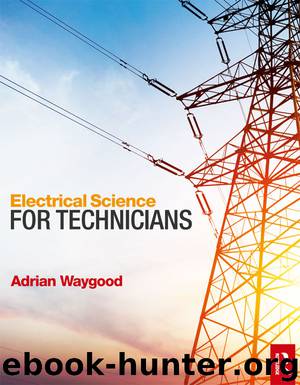Electrical Science for Technicians by Waygood Adrian

Author:Waygood, Adrian
Language: eng
Format: epub
ISBN: 9781317534907
Publisher: Taylor and Francis
Published: 2015-06-18T16:00:00+00:00
Figure 11.11
If, at any given instant, the polarities of the adjacent high- and low-voltage terminals are identical – e.g. both ‘positive’, as in Figure 11.11 (left) – then we describe the transformer as having ‘subtractive polarity’. If, on the other hand, the polarities of the diagonally opposite high- and low-voltage terminals are identical, as in Figure 11.11 (right), then we describe the transformer as having ‘additive polarity’. The significance of the terms, ‘subtractive’ and ‘additive’ polarity, will become apparent, shortly.
If we want to connect two transformers in parallel, exactly the same rule applies as for batteries: i.e. the ‘correct’ connection is when terminals having like (instantaneous) polarities are connected together.
So how do we determine whether a particular single-phase transformer has ‘subtractive’ or ‘additive’ polarity, and what exactly do these two terms actually mean?
If a transformer’s terminals are already labelled, then whether that transformer is ‘subtractive’ or ‘additive’ isn’t really an issue (although you may wish to confirm those labels are correct)! It only becomes an issue if the terminals are unlabelled, in which case we need to be able to label them ourselves.
In the UK, the practice is to label a single-phase transformer’s terminals with a letter, followed by a numerical subscript, where:
►
the high-voltage terminals are labelled with the upper-case letter ‘A’, and the low-voltage terminals with the corresponding lower-case letter ‘a’. When three singlephase transformers are used to form a three-phase transformer bank, the other transformers’ high-voltage terminals are labelled ‘B’ and ‘C’ respectively, and their corresponding low-voltage terminals are labelled ‘b’ and ‘c’.
►
one end of a winding (arbitrarily termed the ‘start’ end) is labelled with an odd-numbered subscript (e.g. ‘A1’), while the other end (termed the ‘finish’ end) is identified with an even-numbered subscript (e.g. ‘A2’).
So, for a straightforward, single-phase, two-winding transformer, the high-voltage terminals will be labelled ‘A1–A2’, and the low-voltage terminals will be labelled ‘a1–a2’. If the transformer has any additional windings, then their terminals can be labelled ‘A3–A4’, ‘a3–a4’, etc., as necessary.
Download
This site does not store any files on its server. We only index and link to content provided by other sites. Please contact the content providers to delete copyright contents if any and email us, we'll remove relevant links or contents immediately.
| Circuits | Digital Design |
| Electric Machinery & Motors | Electronics |
| Fiber Optics | Networks |
| Superconductivity |
Whiskies Galore by Ian Buxton(41883)
Introduction to Aircraft Design (Cambridge Aerospace Series) by John P. Fielding(33064)
Small Unmanned Fixed-wing Aircraft Design by Andrew J. Keane Andras Sobester James P. Scanlan & András Sóbester & James P. Scanlan(32744)
Craft Beer for the Homebrewer by Michael Agnew(18145)
Turbulence by E. J. Noyes(7940)
The Complete Stick Figure Physics Tutorials by Allen Sarah(7310)
Kaplan MCAT General Chemistry Review by Kaplan(6867)
The Thirst by Nesbo Jo(6830)
Bad Blood by John Carreyrou(6555)
Modelling of Convective Heat and Mass Transfer in Rotating Flows by Igor V. Shevchuk(6391)
Learning SQL by Alan Beaulieu(6212)
Weapons of Math Destruction by Cathy O'Neil(6148)
Man-made Catastrophes and Risk Information Concealment by Dmitry Chernov & Didier Sornette(5924)
Digital Minimalism by Cal Newport;(5667)
Life 3.0: Being Human in the Age of Artificial Intelligence by Tegmark Max(5476)
iGen by Jean M. Twenge(5367)
Secrets of Antigravity Propulsion: Tesla, UFOs, and Classified Aerospace Technology by Ph.D. Paul A. Laviolette(5310)
Design of Trajectory Optimization Approach for Space Maneuver Vehicle Skip Entry Problems by Runqi Chai & Al Savvaris & Antonios Tsourdos & Senchun Chai(5011)
Pale Blue Dot by Carl Sagan(4913)
